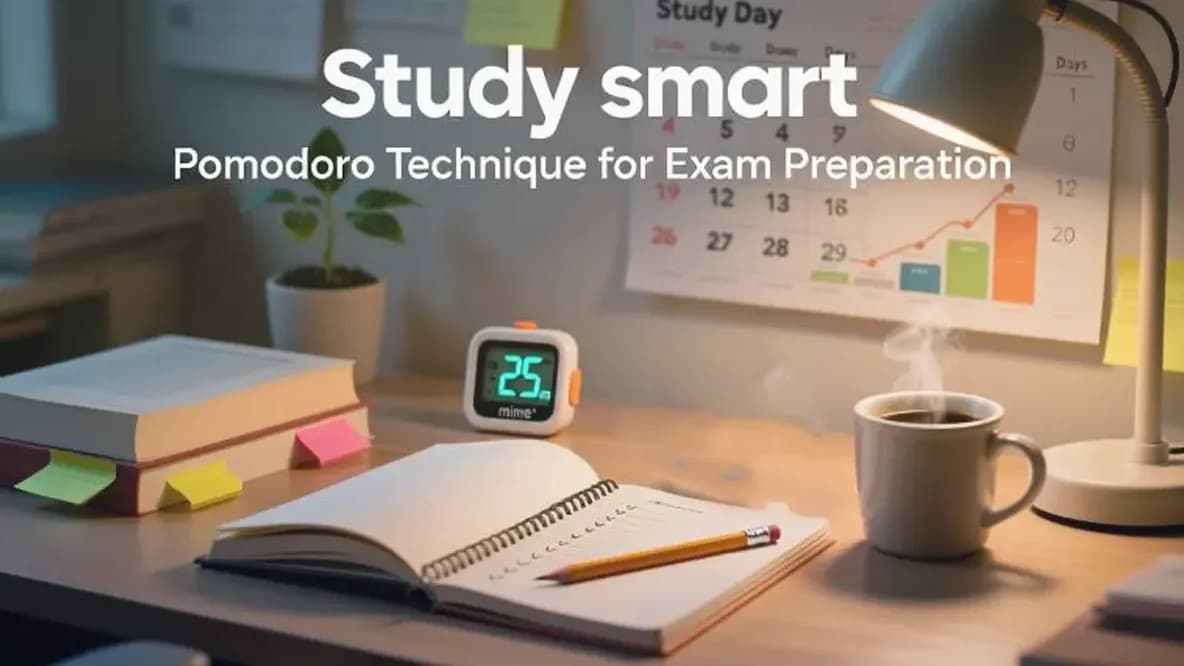Pomodoro Technique for Exam Preparation - Step by Step Guide
Published on September 23, 2025
By Mahabul Islam

For those struggling with exam preparation due to a lack of time management, this blog post can be a game-changer. Every year thousands of students suffer from stress, procrastination and lack of focus before exams. Even after starting to read, the mind keeps drifting away, to the pull of social media or some other form of entertainment. As a result, sitting at the table for hours does not yield the desired results. However, there is a scientifically proven and highly effective solution to this problem – the Pomodoro Technique for Exam Preparation. This simple yet powerful time management study technique will make your studying easier and keep your mind away from distractions. It is not just a method, but a scientific way to improve your study focus method. The Pomodoro Technique is a popular time management method invented by Italian developer Francesco Cirillo in the 1980s. When he was struggling to focus on his studies as a university student, he decided to break up his study sessions into smaller chunks using a tomato-shaped kitchen timer. The Italian word for "tomato" is "Pomodoro," and that's how the method got its name. The basic idea of this method is very simple: Choose a specific task. Set a timer for 25 minutes. Do only one task for these 25 minutes without any breaks. When the timer rings, take a short break of 5 minutes. Thus take a long break (15-30 minutes) after every 4 Pomodoro sessions (ie, 100 minutes of work). This simple yet effective method helps boost your brain's performance and helps you stay focused for longer periods of time. The Pomodoro Technique is extremely easy to use. You can easily start your reading by following these step-by-step instructions: Choose a task: Choose the most important or difficult thing from your to-do list, such as reading a certain chapter, doing some math, or writing an essay. Set the timer: Set a timer for 25 minutes on your phone, an app, or a simple timer. Read carefully: Do only that specific task until the timer runs out. Avoid phones, social media, or any other distractions during these 25 minutes. Take a break: When the timer rings, stop working and take a short break of 5 minutes. At this time, stand up, take a short walk, drink water or splash cold water on the eyes. Repeat: Repeat this cycle three more times. Take a 5-minute break after each 25-minute session. Long breaks: After completing the fourth Pomodoro session, take a long break of 15 to 30 minutes. At this time, you can take a short walk outside or relax your mind completely. If you’re planning your revision, try building a fullstudy schedule for exams alongside the Pomodoro method. There are scientific and psychological reasons behind why the Pomodoro Technique is so effective. Studies have shown that people's attention starts to get distracted after a certain period of time. The Pomodoro Technique solves this problem, as it encourages your brain to give you full attention for a specific period of time (25 minutes). This allows you to consume more information in less time. Reading continuously for long periods of time causes the brain to become tired, which is called "burnout." Regular breaks in the Pomodoro Technique rejuvenate your mind and prevent fatigue. This is much like muscle training, where taking breaks is essential for muscle recovery. According to a popular study, people's mind wanders about 15-20% of the time. Pomodoro minimizes these wanderings. It forces you to complete the work within a certain time frame, which helps in increasing your productivity. This is related to the 80/20 Rule. When your brain takes in some new information, it pauses to organise and store that information in memory. Taking a break gives your brain a chance to process that information. To test your preparation, you can also use tools like theSSC GPA calculator orHSC GPA calculator to estimate results based on your performance. Although the Pomodoro Technique is very simple, some mistakes can reduce your effectiveness. Distractions during breaks: If you spend a 5-minute break on social media or some other distraction, your brain won't be fully rested. Do something that calms the mind during breaks. Additional Customizations: Changing the timer from day one to 45 minutes or 60 minutes instead of 25 minutes is not correct. Follow the basic rules first, then modify as per your needs. To skip the timer: When a task seems too easy, many people want to take a break before the timer runs out. This is contrary to the basic idea of the Pomodoro method. Taking extra stress: Feeling overwhelmed by looking at the timer over and over again. Remember, this is to help you, not add stress. The Pomodoro Technique may not be best for everyone. Some students require longer study sessions. So there are some alternative methods: 80/20 Rule: It can be called Personal Pomodoro. In this rule, you can take a break of 20 minutes after working for 80 minutes. It is good for those who can hold attention for long periods of time. 30-20-10 Study Method: In this method, you can follow a cycle of 30 minutes of reading, 20 minutes of break and 10 minutes of re-reading. It is especially helpful for quick revision before exams. 3-2-1 Study Technique: It follows the structure of 3 hours reading, 2 hours break and 1 hour revision. It is effective for deep and long-term preparation. If you want to improve your answering speed for objective exams, check our tips onmastering MCQ exams The Pomodoro Technique may not work the same way for everyone. For ADHD students: Pomodoro can be very beneficial for students with ADHD (Attention-Deficit/Hyperactivity Disorder). Short, 25-minute sessions seem less daunting to them and regular breaks keep their minds free from distractions. They can start with a 15-minute session if they want. Long study session: Those who have a habit of reading for long periods of time can extend the sessions to 30, 40 or even 50 minutes. Customization: Remember, 25 minutes isn't perfect for everyone, it's just a guideline. You can tailor the sessions to suit your own work style and attention span. Use the app: There are many Pomodoro apps (eg Forest, Focus Keeper) that help you stay focused. Eliminate distractions: Remove mobiles, laptops or other distractions from your reading table. Fix break tasks: Decide in advance what you will do during the break. For example: listening to music, walking, or stretching. Reward System: After completing every four Pomodoros, give yourself a small treat, such as eating a favorite meal or watching a favorite video. The Pomodoro Technique is often compared to flow state or time blocking. Pomodoro vs Flow State: Flow state is when you are so engrossed in the task that time doesn't count. Pomodoro essentially creates a framework for reaching flow state, but it is not the flow state itself. Pomodoro vs Time Blocking: In time blocking you assign a task for a specific period of time. Pomodoro is a subset of this time blocking, which takes small breaks to make work more efficient. Studies have shown that the Pomodoro Technique is more effective than many other techniques in terms of memory retention, academic performance and time management. Is the Pomodoro technique useful for testing? Yes, it is very effective. Its short sessions and regular breaks help increase focus, reduce workload and make studying more productive. What are the disadvantages of the Pomodoro technique? Its biggest disadvantage is its rigidity. Some tasks don't finish in 25 minutes and taking a break in between can be annoying. Also, it may not be equally effective for everyone. How successful is the Pomodoro Technique? Its success rate depends on personal habits and application. However, numerous students and professionals have proven that this approach is highly successful in increasing productivity and focus. Is the Pomodoro Technique good for memorization? Yes, it is very good for memorization. You can quickly read new information in a 25-minute session, and your brain gets a chance to process that information in a 5-minute break. There is nothing more important than time management when preparing for an exam. The Pomodoro Technique is a powerful tool that will help you control your studying and overcome distractions. It is a great skill not only for your exams but also for your future career. To plan better, explore our study schedule for exams and use tools like the NU GPA calculator to track your academic progress.What is the Pomodoro Technique?
How to Use the Pomodoro Technique for Exam Preparation (Step-by-Step)
Why Pomodoro Works for Exams: Science & Psychology
Increased Focus
Reduces work stress (Avoiding Burnout):
Productivity Boost:
Brain Rest
Common Mistakes Students Make with Pomodoro
Variations & Alternatives: 80/20, 30-20-10, 3-2-1 Study Rules
Pomodoro for Different Students: ADHD, Long Study Sessions & Focus Hacks
Tips to Maximize Pomodoro for Exam Success
Pomodoro Technique vs Other Study Methods
FAQ about Pomodoro Techniques for Exam Preparation
Conclusion
Written By
Tags:
Related Blogs:
Comments: 0
Recent Posts:

Effective Note-Taking Methods for Better Learning
11/21/2025

How to Improve Concentration While Studying: Science-backed BD Student Guide
11/11/2025

10 Proven Memorization Techniques for Students to Boost Memory Fast
11/5/2025

Top 15 Practical Exam Tips for Students: Strategies to Score Full Marks
10/28/2025

How to Reduce Exam Stress and Anxiety - Step by Step Guide
10/3/2025

